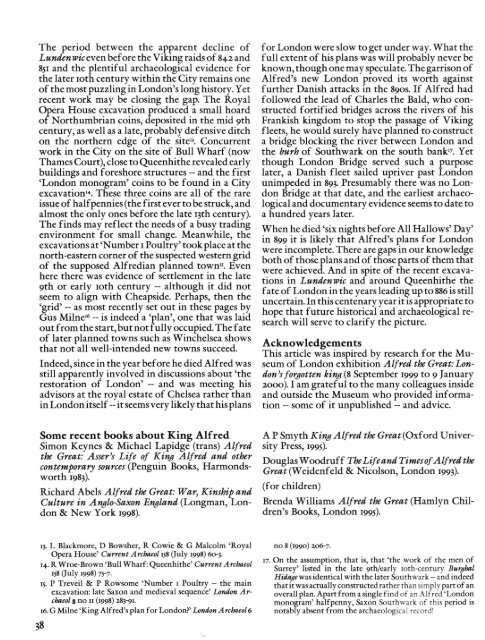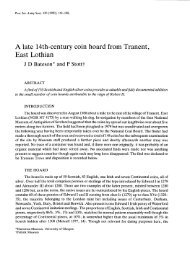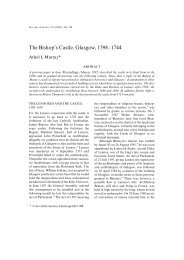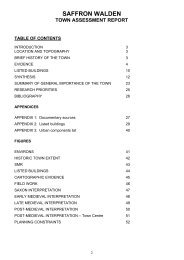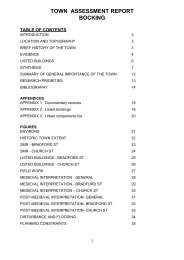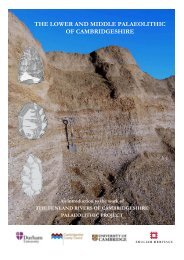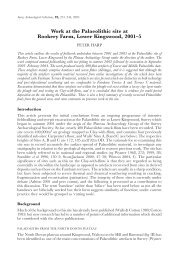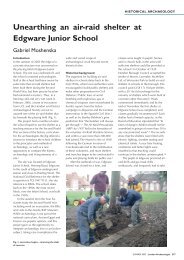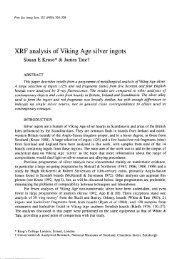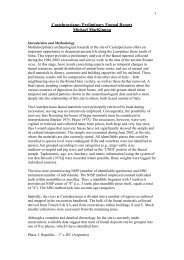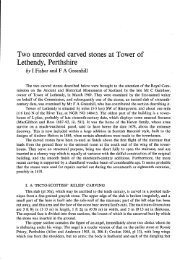King Alfred's London and London's King Aifred
King Alfred's London and London's King Aifred
King Alfred's London and London's King Aifred
You also want an ePaper? Increase the reach of your titles
YUMPU automatically turns print PDFs into web optimized ePapers that Google loves.
The period between the apparent decline of<br />
Lundenwiceven before the Viking raids of842 <strong>and</strong><br />
851 <strong>and</strong> the plentiful archaeological evidence for<br />
the later roth century within the City remains one<br />
of the most puzzling in <strong>London</strong>'s long history. Yet<br />
recent work may be closing the gap. The Royal<br />
Opera House excavation produced a small hoard<br />
of Northumbrian coins, deposited in the mid oth<br />
century, as well as a late, probably defensive ditch<br />
on the northern edge of the sire», Concurrent<br />
work in the City on the site of Bull Wharf (now<br />
ThamesCourt), close toQueenhithe revealed early<br />
buildings <strong>and</strong> foreshore structures -- <strong>and</strong> the first<br />
'<strong>London</strong> monogram' coins to be found in a City<br />
excavation», These three coins are all of the rare<br />
issue of halfpennies(the first ever to be struck, <strong>and</strong><br />
almost the only ones before the late rjth century).<br />
The finds may reflect the needs of a busy trading<br />
environment for small change. Meanwhile, the<br />
excavations at'Number I Poultry' took placeat the<br />
north-eastern cornerof the suspected western grid<br />
of the supposed Alfredian planned towns. Even<br />
here there was evidence of settlement in the late<br />
oth or early roth century -- although it did not<br />
seem to align with Cheapside. Perhaps, then the<br />
'grid' -- as most recently set out in these pages by<br />
Gus Milne« -- is indeed a 'plan', one that was laid<br />
outfrom thestart, but notfully occupied.The fate<br />
of later planned towns such as Winchelsea shows<br />
that not all well-intended new towns succeed.<br />
Indeed, since in the year before he died Alfred was<br />
still apparently involved in discussions about 'the<br />
restoration of <strong>London</strong>' -- <strong>and</strong> was meeting his<br />
advisors at the royal estate of Chelsea rather than<br />
in <strong>London</strong>itself--itseems very likely that his plans<br />
Some recent books about <strong>King</strong> Alfred<br />
Simon Keynes & Michael Lapidge (trans) Alfred<br />
the Great: Asser's Life of <strong>King</strong> Alfred <strong>and</strong> other<br />
contemporary sources (Penguin Books, Harmondsworth<br />
1983).<br />
Richard Abels Alfred the Great: War, Kinship <strong>and</strong><br />
Culture in Anglo-Saxon Engl<strong>and</strong> (Longman, <strong>London</strong><br />
& New York 1998).<br />
13. L Blackrnore, D Bowsher, R Cowie & G Malcolm ' Royal<br />
Opera House' Current Archaeol IS8(July 1998) 60-3.<br />
14-. R Wroe-Brown 'Bull Wharf: Queenhithe' Current Archaeol<br />
Is8 (Jul Y1998) 7S-7·<br />
IS. P Treveil & P Rowsome 'Number 1 Poultry -- th e main<br />
excavation: late Saxon <strong>and</strong> medieval sequence' <strong>London</strong> Archaeol<br />
s; no II (1998) 283-91.<br />
16. G Milne '<strong>King</strong> <strong>Alfred's</strong> plan for <strong>London</strong>?' <strong>London</strong> A rchaeol6<br />
for <strong>London</strong> were slow to get under wa y. What the<br />
full extent of his plans was will probably never be<br />
known, though onemay speculate.Thegarrisonof<br />
Alfred 's new <strong>London</strong> proved its worth against<br />
further Danish attacks in the 890S. If Alfred had<br />
followed the lead of Charles the Bald, who constructed<br />
fortified bridges across the rivers of his<br />
Frankish kingdom to stop the passage of Viking<br />
fleets, he would surely have planned to construct<br />
a bridge blocking the river between <strong>London</strong> <strong>and</strong><br />
the burh of Southwark on the south bankv. Yet<br />
though <strong>London</strong> Bridge served such a purpose<br />
later, a Danish fleet sailed upriver past <strong>London</strong><br />
unimpeded in 893. Presumably there was no <strong>London</strong><br />
Bridge at that date, <strong>and</strong> the earliest archaeological<br />
<strong>and</strong> documentary evidence seems to date to<br />
a hundred years later.<br />
When he died 'six nights before All Hallows' Day'<br />
in 899 it is likely that <strong>Alfred's</strong> plans for <strong>London</strong><br />
were incomplete. There are gaps in our knowledge<br />
both of those plans <strong>and</strong> of those partsof them that<br />
were achieved. And in spite of the recent excavations<br />
in Lundenwic <strong>and</strong> around Queenhithe the<br />
f ateof <strong>London</strong> in the years leading up to 886 is still<br />
uncertain.In this centenary year it is appropriate to<br />
hope that future historical <strong>and</strong> archaeological research<br />
will serve to clarify the picture.<br />
Acknowledgements<br />
T his article was inspired by research for the Museum<br />
of <strong>London</strong> exhibition Alfred the Great:<strong>London</strong>'sforgotten<br />
king (8 September 1999 to 9 January<br />
2000). I am grateful to the many colleagues inside<br />
<strong>and</strong> outside the Museum who provided information<br />
-- some of it unpublished -- <strong>and</strong> advice.<br />
A P Smyth <strong>King</strong> Alfred theGreat (Oxf ord University<br />
Press, 1995).<br />
DouglasWoodruff TheLife<strong>and</strong> Times ofAlfred the<br />
Great (Weidenfeld & Nicolson, <strong>London</strong> 1993).<br />
(f or children)<br />
Brenda Williams Alfred the Great (Hamlyn Children's<br />
Books, <strong>London</strong> 1995).<br />
no 8 (1990) 206-7.<br />
17. On the assumption , that is, tha t 'the work of th e men of<br />
Sur rey' listed in the late orh/early roth-ccnrury Burghal<br />
Hidagewas identical with th e late r Sout hwa rk - <strong>and</strong> indeed<br />
th at it was actually con structed rather than simply parrof an<br />
overall plan. Apart from a single fi nd of an AIfred '<strong>London</strong><br />
monogram' halfpenny, Saxon Southwark of this period is<br />
no tably absent from the arch aeological record!


